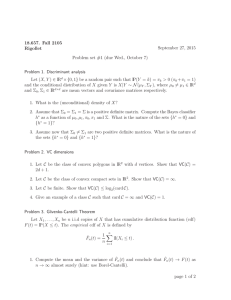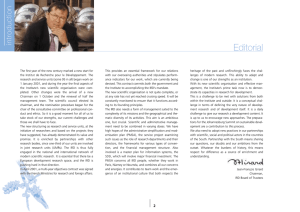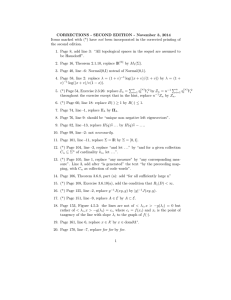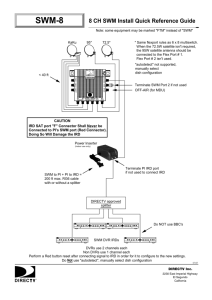18.657. Fall 2105 November 6, 2015 Rigollet
advertisement
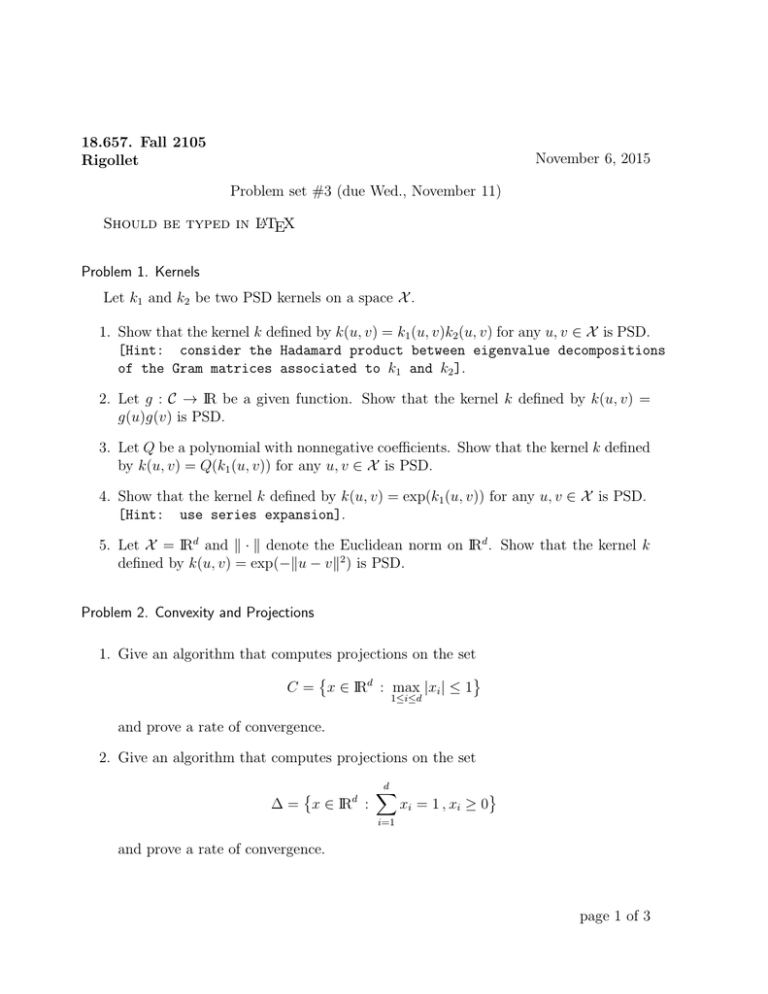
18.657. Fall 2105
Rigollet
November 6, 2015
Problem set #3 (due Wed., November 11)
Should be typed in LATEX
Problem 1. Kernels
Let k1 and k2 be two PSD kernels on a space X .
1. Show that the kernel k defined by k(u, v) = k1 (u, v)k2(u, v) for any u, v ∈ X is PSD.
[Hint: consider the Hadamard product between eigenvalue decompositions
of the Gram matrices associated to k1 and k2 ].
2. Let g : C → IR be a given function. Show that the kernel k defined by k(u, v) =
g(u)g(v) is PSD.
3. Let Q be a polynomial with nonnegative coefficients. Show that the kernel k defined
by k(u, v) = Q(k1 (u, v)) for any u, v ∈ X is PSD.
4. Show that the kernel k defined by k(u, v) = exp(k1 (u, v)) for any u, v ∈ X is PSD.
[Hint: use series expansion].
5. Let X = IRd and k · k denote the Euclidean norm on IRd . Show that the kernel k
defined by k(u, v) = exp(−ku − vk2 ) is PSD.
Problem 2. Convexity and Projections
1. Give an algorithm that computes projections on the set
C = x ∈ IRd : max |xi | ≤ 1
1≤i≤d
and prove a rate of convergence.
2. Give an algorithm that computes projections on the set
d
X
d
∆ = x ∈ IR :
xi = 1 , xi ≥ 0
i=1
and prove a rate of convergence.
page 1 of 3
3. Recall that the Euclidean norm on n×n real matrices is also known as the Frobenius
norm and is defined by kMk2 = Trace(M ⊤ M). Let Sn be the set of n × n symmetric
matrices with real entries. Let Sn+ denote the set of n×n symmetric positive definite
matrices with real entries, that is M ∈ Sn if and only if M ∈ Sn and
x⊤ Mx ≥ 0,
∀ x ∈ IRn .
(a) Show that Sn+ is convex and closed.
(b) Give an explicit formula for the projection (with respect to the Frobenius norm)
of a matrix M ∈ Sn onto Sn+
4. Let C ⊂ IRd be a closed convex set and for any x ∈ IRd denote by π(x) its projection
onto C. Show that for any x, y ∈ IRd , it holds
kπ(x) − π(y)k ≤ kx − yk
where k · k denotes the Euclidean norm.
Show that for any y ∈ C,
kπ(x) − yk ≤ kx − yk ,
Problem 3. Convex conjugate
For any function f : D ⊂ IRd → IR, define its convex conjugate f ∗ by
f ∗ (y) = sup y ⊤ x − f (x) .
(1)
x∈C
The domain of the function f ∗ is taken to be the set D = {y ∈ IRd : f ∗ (y) < ∞}.
1. Find f ∗ and D if
(a) f (x) = 1/x, C = (0, ∞),
(b) f (x) = 12 |x|22 , C = IRd ,
P
(c) f (x) = log dj=1 exp(xj ), x = (x1 , . . . , xd ), C = IRd .
Let f be strictly convex and differentiable and that C = IRd .
2. Show that f (x) ≥ f ∗∗ (x) for all x ∈ C.
3. Show that the supremum in (1) is attained at x∗ such that ∇f (x∗ ) = y.
4. Recall that Df (·, ·) denotes the Bregman divergence associated to f . Show that
Df (x, y) = Df ∗ ∇f (y), ∇f (x)
page 2 of 3
Problem 4. Around gradient descent
In what follows, we want to solve the constrained problem:
min f (x) .
x∈C
where f is a L-Lipschitz convex function and C ⊂ IRd is a compact convex set with
diameter at most R (in Euclidean norm). Denote by x∗ a minimum of f on C.
1. Assume that we replace the updates in the projected gradient descent algorithm by
gs
,
kgs k
= πC (ys+1) ,
ys+1 = xs − η
xs+1
gs ∈ ∂f (xs ) .
where πC (·) is the projection onto C.
What guarantees can you prove for this algorithm under the same assumptions?
2. Consider the following updates:
ys ∈ argmin ∇f (xs )⊤ y
y∈C
xs+1 = (1 − γs )xs + γs ys ,
where γs = 2/(s + 1).
In what follows, we assume that f is differentiable and β-smooth:
f (y) − f (x) ≤ ∇f (x)⊤ (y − x) +
β
|y − x|22 .
2
(a) Show that
f (xs+1 ) − f (xs ) ≤ γs (f (x∗ ) − f (xs )) +
β 2 2
γ R
2 s
(b) Conclude that for any k ≥ 2,
f (xk ) − f (x∗ ) ≤
2βR2
.
k+1
page 3 of 3
MIT OpenCourseWare
http://ocw.mit.edu
18.657 Mathematics of Machine Learning
Fall 2015
For information about citing these materials or our Terms of Use, visit: http://ocw.mit.edu/terms.
